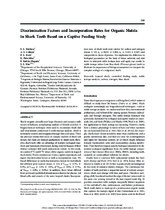Mostrar el registro sencillo del documento
Discrimination factors and incorporation rates for organic matrix in shark teeth based on a captive feeding study
| dc.coverage.spatial | Bogotá, Colombia | spa |
| dc.creator | Zeichner, S. S. | |
| dc.creator | Colman, A. S. | |
| dc.creator | Koch, P. L. | |
| dc.creator | Polo-Silva, C. | |
| dc.creator | Galván-Magaña, F. | |
| dc.creator | Kim, S. L. | |
| dc.date.accessioned | 2020-04-29T19:22:49Z | |
| dc.date.available | 2020-04-29T19:22:49Z | |
| dc.date.created | 2017 | |
| dc.identifier.issn | 1522-2152 | spa |
| dc.identifier.other | https://www.journals.uchicago.edu/doi/abs/10.1086/689192 | spa |
| dc.identifier.uri | http://hdl.handle.net/20.500.12010/9075 | |
| dc.description.abstract | Sharks migrate annually over large distances and occupy a wide variety of habitats, complicating analysis of lifestyle and diet. A biogeochemical technique often used to reconstruct shark diet and environment preferences is stable isotope analysis, which is minimally invasive and integrates through time and space. There are previous studies that focus on isotopic analysis of shark soft tissues, but there are limited applications to shark teeth. However, shark teeth offer an advantage of multiple ecological snapshots and minimum invasiveness during removal because of their distinct conveyor belt tooth replacement system. In this study, we analyze d13C and d15N values of the organic matrix in leopard shark teeth (Triakis semifasciata) from a captive experiment and report discrimination factors as well as incorporation rates. We found differences in tooth discrimination factors for individuals fed different prey sources (mean 5 SD; D13Csquid p 4.7‰ 5 0.5‰, D13Ctilapia p 3.1‰ 5 1.0‰, D15Nsquid p 2.0‰ 5 0.7‰, D15Ntilapia p 2.8‰ 5 0.6‰). In addition, these values differed from previously published discrimination factors for plasma, red blood cells, and muscle of the same leopard sharks. Incorporation rates of shark teeth were similar for carbon and nitrogen (mean 5 SE; lC p 0.021 5 0.009, lN p 0.024 5 0.007) and comparable to those of plasma. We emphasize the difference in biological parameters on the basis of tissue substrate and diet items to interpret stable isotope data and apply our results to stable isotope values from blue shark (Prionace glauca) teeth to illustrate the importance of biological parameters to interpret the complex ecology of a migratory shark. | spa |
| dc.format.extent | 16 páginas | spa |
| dc.format.mimetype | application/pdf | spa |
| dc.publisher | Universidad de Bogotá Jorge Tadeo Lozano | spa |
| dc.subject | Leopard shark | spa |
| dc.subject | Controlled feeding study | spa |
| dc.subject | Stable isotope analysis | spa |
| dc.subject | Carbon | spa |
| dc.subject | Nitrogen | spa |
| dc.subject | Blue shark | spa |
| dc.title | Discrimination factors and incorporation rates for organic matrix in shark teeth based on a captive feeding study | spa |
| dc.type.local | Artículo | spa |
| dc.subject.lemb | Tiburones -- Investigaciones | spa |
| dc.subject.lemb | Isótopos del carbono | spa |
| dc.rights.accessrights | info:eu-repo/semantics/openAccess | spa |
| dc.type.hasversion | info:eu-repo/semantics/acceptedVersion | spa |
| dc.rights.local | Abierto (Texto Completo) | spa |
| dc.identifier.doi | 10.1086/689192 | spa |
| dc.identifier.instname | instname:Universidad de Bogotá Jorge Tadeo Lozano | spa |
| dc.identifier.reponame | reponame:Repositorio Institucional de la Universidad de Bogotá Jorge Tadeo Lozano | spa |
| dc.type.driver | info:eu-repo/semantics/article | spa |
Archivos en el documento
Este documento aparece en la(s) siguiente(s) colección(ones)
-
Año 2017 [150]

